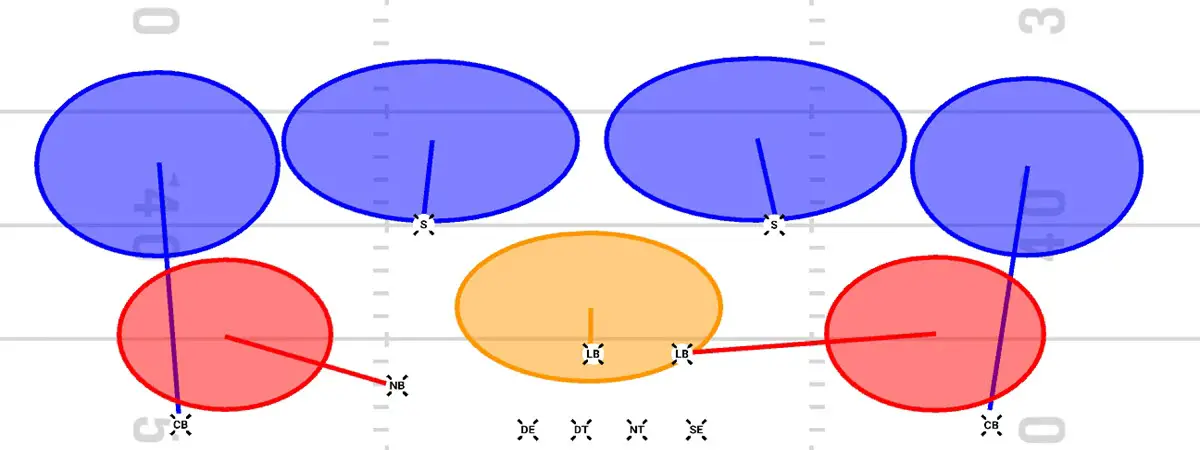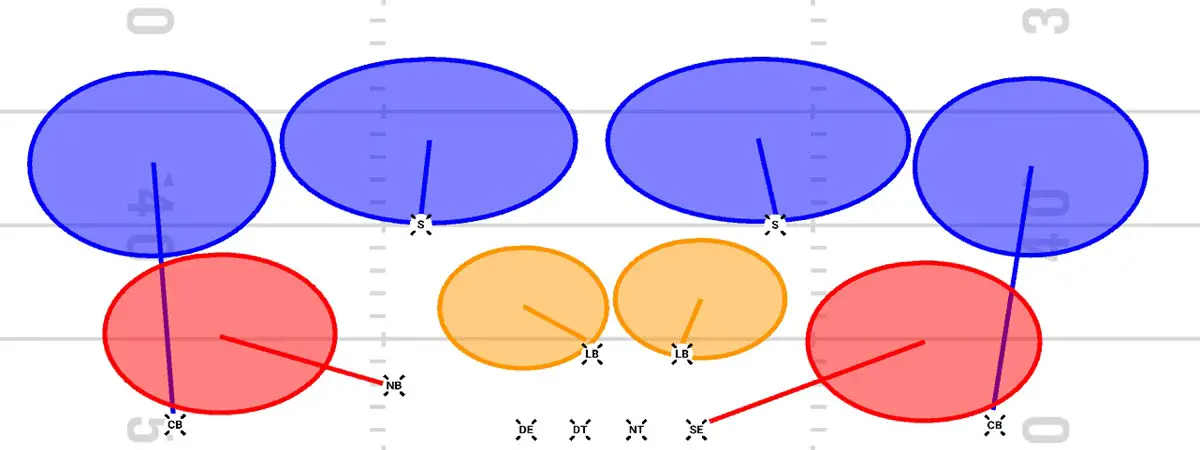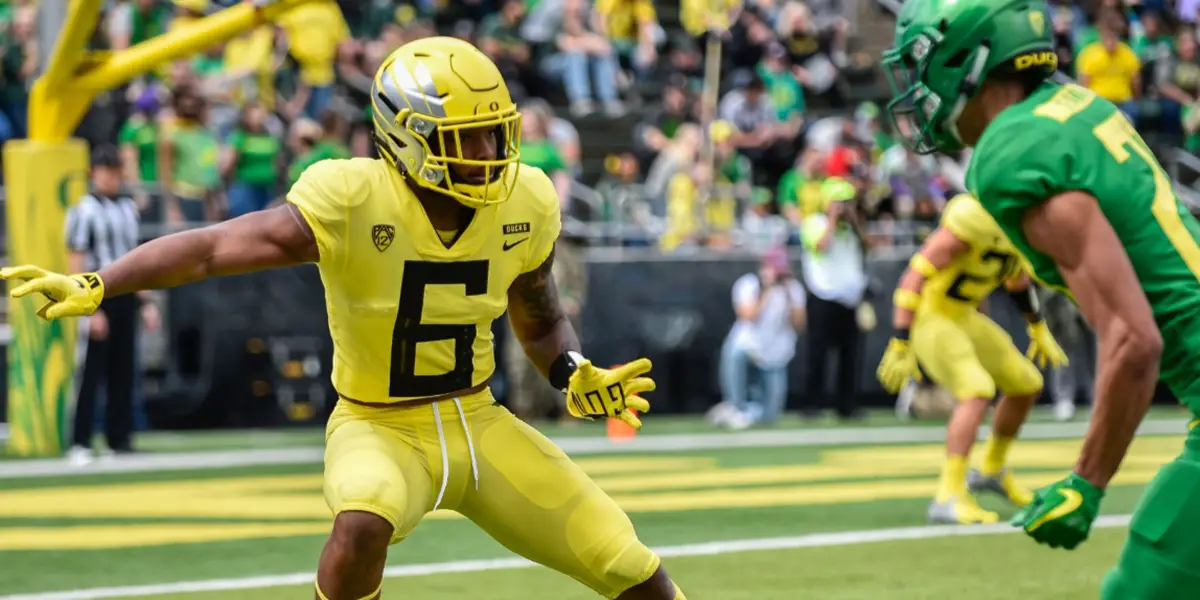New Oregon Duck defensive coordinator Andy Avalos prefers that his defense stay multiple and mix up its coverages, but quarters coverage may be his most dependable scheme on the back end.
Avalos plays quarters in a more aggressive fashion, allowing his corners to play closer to the line of scrimmage in order to jam receivers and knock them off their routes before bailing out. Additionally, the 10-to-12-yard depth of the safeties allows for more aggressive run support.

Receiver Numbering
The diagram above is used as reference through the rest of the article. It will allow you to understand what I mean when I’m referring to receivers and their designated numbers within the formation.

Quarters Coverage
The responsibilities for each position in quarters coverage are pretty straightforward, making the attack simple yet effective, when executed well.
The corners probably have the most work in this scheme. Their first assignment is the No. 1 receiver. The No. 1 receiver is the most outside receiver on either side of the formation. If that receiver stays vertical beyond 10 to 12 yards, the corner essentially plays man coverage on him. If the No. 1 runs anything shallower, the corner continues dropping to take any out-breaking vertical route by the No. 2 receiver. Should the No. 1 get to the 10-to-12-yard depth but break inside, he becomes the safety’s responsibility, and the corner takes on any vertical route by the No. 2.
Safeties will align 10-12 yards off the line of scrimmage and inside the No. 2 receiver if he is split out, or outside of him if he is attached, such as with a traditional a tight end. His responsibility will be the No. 2 receiver on any vertical route that reaches the 8-to-12-yard depth. If the No. 2 runs a route shallow of that depth, he will support the corner and attempt to rob/under cut the No. 1 receiver.
The middle/hook defender (orange on the above diagram) is simply responsible for the middle portion of the field underneath the safeties. Anything that crosses through that zone is his. The only time that this changes is if the offense is in any three-by-one formation. In that case, the middle/hook defender must run with the No. 3 receiver to the trips side on any vertical route until he receives support from the safety over the top.
The flat defenders (red on the above diagram) are responsible for the No. 2’s routes to the outside, and the No. 1 if the route brings him inside prior to that 10-to-12-yard range (such as a slant or drag). He must also be aware of any route to the flat by the No. 3 receiver.
In the video above, you’ll see the Ducks running the quarters coverage in this year’s spring game. Watch this video over a couple times to see how each position’s responsibilities unfold on the play. Justin Herbert targets Brenden Schooler, the No. 1 receiver, who’s running a vertical route beyond 12 yards. This prompts Thomas Graham to go with him, offering very little room to make a catch. It would require Herbert to throw a perfect pass, which he doesn’t accomplish here.

Quarters Coverage Four Under
The Ducks will also run a variation of quarters where they drop the Stud defensive end into the flat (see diagram above). This gives the defense four zones underneath. Now that the Stud is playing the flat to the short side of the field, the second linebacker is able to become an additional middle/hook defender. Having four defenders over top and four underneath makes it especially difficult for the quarterback and receivers to find open space, though you do sacrifice your pass rush.
In the video above, again from this year’s spring game, you’ll see the Ducks running quarters coverage with four under. Notice how DJ Johnson (No. 7) does a great job carrying the No. 2 receiver to the outside without losing track of the No. 3 slipping into the flat. That’s fantastic recognition and a great understanding of his responsibilities.
The quarters coverage is effective on a couple of different levels. Not only does the shallow safety depth aid against the run, but the restrictiveness that the coverage produces in the pass game forces the quarterback to be patient. There aren’t many college QBs that are patient enough to continue to throw underneath or check down. As that fortitude begins to crumble, the Ducks will feast.
Coach Eric Boles
Newark, Ohio Top Photo Credit: Kevin Cline
 Spencer Thomas, the FishDuck.com Volunteer Editor for this article, is an attorney for the Social Security Administration in Atlanta, Georgia, and coaches High School Football for Hillgrove HS in Powder Springs, GA.
Spencer Thomas, the FishDuck.com Volunteer Editor for this article, is an attorney for the Social Security Administration in Atlanta, Georgia, and coaches High School Football for Hillgrove HS in Powder Springs, GA.
Eric resides in Central Ohio, just outside the capital city of Columbus. He is a former offensive assistant and return game coordinator for the Ohio State – Newark/Central Ohio Technical College Titans football program.
He is an OSU-N graduate, having completed a Bachelor of Arts program in psychology.

